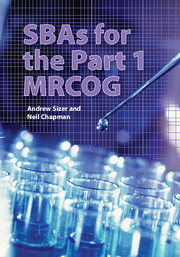Book contents
- Frontmatter
- Contents
- Preface
- About the authors
- Acknowledgements
- Abbreviations
- Foreword
- How to use this book
- 1 Structure and content of the Part 1 MRCOG examination
- 2 Part 1 MRCOG blueprinting matrix, syllabus topics and example questions for paper 1
- 3 Part 1 MRCOG blueprinting matrix, syllabus topics and example questions for paper 2
- 4 Mock paper: paper 1
- 5 Mock paper: paper 2
- Appendix 1 Blueprinting matrix for the Part 1 MRCOG examination
- Appendix 2 Example SBA answer sheet
- Appendix 3 Answers to chapter 2 questions
- Appendix 4 Answers to chapter 3 questions
- Appendix 5 Answers to mock paper 1 (chapter 4)
- Appendix 6 Answers to mock paper 2 (chapter 5)
4 - Mock paper: paper 1
Published online by Cambridge University Press: 05 July 2014
- Frontmatter
- Contents
- Preface
- About the authors
- Acknowledgements
- Abbreviations
- Foreword
- How to use this book
- 1 Structure and content of the Part 1 MRCOG examination
- 2 Part 1 MRCOG blueprinting matrix, syllabus topics and example questions for paper 1
- 3 Part 1 MRCOG blueprinting matrix, syllabus topics and example questions for paper 2
- 4 Mock paper: paper 1
- 5 Mock paper: paper 2
- Appendix 1 Blueprinting matrix for the Part 1 MRCOG examination
- Appendix 2 Example SBA answer sheet
- Appendix 3 Answers to chapter 2 questions
- Appendix 4 Answers to chapter 3 questions
- Appendix 5 Answers to mock paper 1 (chapter 4)
- Appendix 6 Answers to mock paper 2 (chapter 5)
Summary
Answers to the questions in this chapter can be found in appendix 5.
1 From which germ cell layer are the ureters derived?
A Ectoderm
B Endoderm
C Mesoderm
D Trophoblast
E Yolk sac
2 The urachus becomes fibrosed and obliterated to form which structure in the adult?
A Falciform ligament
B Lateral umbilical ligament
C Ligamentum teres
D Medial umbilical ligament
E Median umbilical ligament
3 A pudendal nerve block is used in obstetrics to provide analgesia for instrumental delivery. The pudendal nerve derives fibres from which spinal segments?
A L4-5
B L5, S1
C S2-4
D S3-5
E S4-5
4 Which structure is attached to the lateral aspect of the cervix and the lateral wall of the pelvis and is one of the main supports of the uterus?
A Broad ligament
B Ovarian ligament
C Round ligament
D Transverse cervical ligament
E Uterosacral ligament
5 The majority of the lymphatic drainage of the breast passes to which group of lymph nodes?
A Axillary nodes
B Inguinal nodes
C Para-aortic nodes
D Superficial cervical nodes
E Supraclavicular nodes
6 How many tendinous intersections are there in each rectus abdominis muscle?
A 1
B 2
C 3
D 4
E 5
7 The inferior epigastric artery is a branch of which artery?
A External iliac artery
B Femoral artery
C Internal iliac artery
D Umbilical artery
E Uterine artery
- Type
- Chapter
- Information
- SBAs for the Part 1 MRCOG , pp. 73 - 90Publisher: Cambridge University PressPrint publication year: 2012



